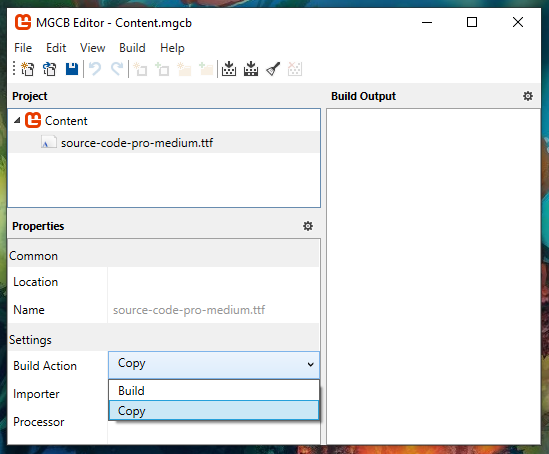Persistent game settings
Preserve and load data between game runs in a json file.
This tutorial builds on top of Fullscreen.
You will learn how to load and save game settings using C#'s source generator. You will also learn how to draw text with FontStashSharp.
Project setup
The completed project can be found here.
Libraries
This tutorial relies on two libraries: Apos.Input and FontStashSharp.
You can install them with the following two commands:
dotnet add package Apos.Input
dotnet add package FontStashSharp.MonoGame
Apos.Input provides a simplified API over the MonoGame mouse and keyboard API.
FontStashSharp is a runtime text rendering library. It manages a texture behind the scene to render glyphs on demand.
Assets
Add the following font to the Content folder and call it source-code-pro-medium.ttf. Download source-code-pro-medium.ttf
Content pipeline
Open Content.mgcb using the MonoGame Content Builder Editor interface. (Read Get started to learn how to get it.) Add the font to the content pipeline editor as an existing item:

Change the build action to copy.

If you open Content.mgcb as a text file, this is the content you will see:
#----------------------------- Global Properties ----------------------------#
/outputDir:bin/$(Platform)
/intermediateDir:obj/$(Platform)
/platform:DesktopGL
/config:
/profile:HiDef
/compress:True
#-------------------------------- References --------------------------------#
#---------------------------------- Content ---------------------------------#
#begin source-code-pro-medium.ttf
/copy:source-code-pro-medium.ttf
Source code
Settings.cs
Create a Settings.cs file. Paste this content in:
using System.Text.Json.Serialization;
namespace GameProject {
public class Settings {
public int X { get; set; } = 320;
public int Y { get; set; } = 180;
public int Width { get; set; } = 1280;
public int Height { get; set; } = 720;
public bool IsFixedTimeStep { get; set; } = true;
public bool IsVSync { get; set; } = false;
public bool IsFullscreen { get; set; } = false;
public bool IsBorderless { get; set; } = false;
}
[JsonSourceGenerationOptions(
PropertyNamingPolicy = JsonKnownNamingPolicy.CamelCase,
WriteIndented = true)]
[JsonSerializable(typeof(Settings))]
internal partial class SettingsContext : JsonSerializerContext { }
}
Game1.cs
using System;
using System.IO;
using System.Text.Json;
using System.Text.Json.Serialization.Metadata;
using Microsoft.Xna.Framework;
using Microsoft.Xna.Framework.Graphics;
using Microsoft.Xna.Framework.Input;
using Apos.Input;
using FontStashSharp;
namespace GameProject {
public class Game1 : Game {
public Game1() {
_graphics = new GraphicsDeviceManager(this);
IsMouseVisible = true;
Content.RootDirectory = "Content";
_settings = EnsureJson("Settings.json", SettingsContext.Default.Settings);
}
protected override void Initialize() {
Window.AllowUserResizing = true;
IsFixedTimeStep = _settings.IsFixedTimeStep;
_graphics.SynchronizeWithVerticalRetrace = _settings.IsVSync;
_settings.IsFullscreen = _settings.IsFullscreen || _settings.IsBorderless;
RestoreWindow();
if (_settings.IsFullscreen) {
ApplyFullscreenChange(false);
}
base.Initialize();
}
protected override void LoadContent() {
_s = new SpriteBatch(GraphicsDevice);
InputHelper.Setup(this);
_fontSystem = new FontSystem();
_fontSystem.AddFont(TitleContainer.OpenStream($"{Content.RootDirectory}/source-code-pro-medium.ttf"));
}
protected override void UnloadContent() {
if (!_settings.IsFullscreen) {
SaveWindow();
}
SaveJson("Settings.json", _settings, SettingsContext.Default.Settings);
base.UnloadContent();
}
protected override void Update(GameTime gameTime) {
InputHelper.UpdateSetup();
if (_quit.Pressed())
Exit();
if (_toggleFullscreen.Pressed()) {
ToggleFullscreen();
}
if (_toggleBorderless.Pressed()) {
ToggleBorderless();
}
if (_resetSettings.Pressed()) {
bool oldIsFullscreen = _settings.IsFullscreen;
_settings = new Settings();
SaveJson("Settings.json", _settings, SettingsContext.Default.Settings);
ApplyFullscreenChange(oldIsFullscreen);
}
InputHelper.UpdateCleanup();
base.Update(gameTime);
}
protected override void Draw(GameTime gameTime) {
GraphicsDevice.Clear(Color.Black);
var font = _fontSystem.GetFont(24);
string mode = _settings.IsBorderless ? "Borderless" : _settings.IsFullscreen ? "Fullscreen" : "Window";
Vector2 modeCenter = font.MeasureString(mode) / 2f;
Vector2 windowCenter = new Vector2(GraphicsDevice.Viewport.Width, GraphicsDevice.Viewport.Height) / 2f;
_s.Begin();
_s.DrawString(font, mode, windowCenter - modeCenter, Color.White);
_s.End();
base.Draw(gameTime);
}
public void ToggleFullscreen() {
bool oldIsFullscreen = _settings.IsFullscreen;
if (_settings.IsBorderless) {
_settings.IsBorderless = false;
} else {
_settings.IsFullscreen = !_settings.IsFullscreen;
}
ApplyFullscreenChange(oldIsFullscreen);
}
public void ToggleBorderless() {
bool oldIsFullscreen = _settings.IsFullscreen;
_settings.IsBorderless = !_settings.IsBorderless;
_settings.IsFullscreen = _settings.IsBorderless;
ApplyFullscreenChange(oldIsFullscreen);
}
public static string GetPath(string name) => Path.Combine(AppDomain.CurrentDomain.BaseDirectory, name);
public static T LoadJson<T>(string name, JsonTypeInfo<T> typeInfo) where T : new() {
T json;
string jsonPath = GetPath(name);
if (File.Exists(jsonPath)) {
json = JsonSerializer.Deserialize(File.ReadAllText(jsonPath), typeInfo)!;
} else {
json = new T();
}
return json;
}
public static void SaveJson<T>(string name, T json, JsonTypeInfo<T> typeInfo) {
string jsonPath = GetPath(name);
Directory.CreateDirectory(Path.GetDirectoryName(jsonPath)!);
string jsonString = JsonSerializer.Serialize(json, typeInfo);
File.WriteAllText(jsonPath, jsonString);
}
public static T EnsureJson<T>(string name, JsonTypeInfo<T> typeInfo) where T : new() {
T json;
string jsonPath = GetPath(name);
if (File.Exists(jsonPath)) {
json = JsonSerializer.Deserialize(File.ReadAllText(jsonPath), typeInfo)!;
} else {
json = new T();
string jsonString = JsonSerializer.Serialize(json, typeInfo);
Directory.CreateDirectory(Path.GetDirectoryName(jsonPath)!);
File.WriteAllText(jsonPath, jsonString);
}
return json;
}
private void ApplyFullscreenChange(bool oldIsFullscreen) {
if (_settings.IsFullscreen) {
if (oldIsFullscreen) {
ApplyHardwareMode();
} else {
SetFullscreen();
}
} else {
UnsetFullscreen();
}
}
private void ApplyHardwareMode() {
_graphics.HardwareModeSwitch = !_settings.IsBorderless;
_graphics.ApplyChanges();
}
private void SetFullscreen() {
SaveWindow();
_graphics.PreferredBackBufferWidth = GraphicsAdapter.DefaultAdapter.CurrentDisplayMode.Width;
_graphics.PreferredBackBufferHeight = GraphicsAdapter.DefaultAdapter.CurrentDisplayMode.Height;
_graphics.HardwareModeSwitch = !_settings.IsBorderless;
_graphics.IsFullScreen = true;
_graphics.ApplyChanges();
}
private void UnsetFullscreen() {
_graphics.IsFullScreen = false;
RestoreWindow();
}
private void SaveWindow() {
_settings.X = Window.ClientBounds.X;
_settings.Y = Window.ClientBounds.Y;
_settings.Width = Window.ClientBounds.Width;
_settings.Height = Window.ClientBounds.Height;
}
private void RestoreWindow() {
Window.Position = new Point(_settings.X, _settings.Y);
_graphics.PreferredBackBufferWidth = _settings.Width;
_graphics.PreferredBackBufferHeight = _settings.Height;
_graphics.ApplyChanges();
}
GraphicsDeviceManager _graphics;
SpriteBatch _s;
FontSystem _fontSystem;
Settings _settings;
ICondition _quit =
new AnyCondition(
new KeyboardCondition(Keys.Escape),
new GamePadCondition(GamePadButton.Back, 0)
);
ICondition _toggleFullscreen =
new AllCondition(
new KeyboardCondition(Keys.LeftAlt),
new KeyboardCondition(Keys.Enter)
);
ICondition _toggleBorderless = new KeyboardCondition(Keys.F11);
ICondition _resetSettings = new KeyboardCondition(Keys.R);
}
}
Explanation
We’ll be loading and storing our settings in a Settings.json file. That file will be placed next to the game’s executable. On Windows that executable would be MyGame.exe. To get the executable’s directory, System provides AppDomain.BaseDirectory.
public static string GetPath(string name) => Path.Combine(AppDomain.CurrentDomain.BaseDirectory, name);
The following functions take a generic parameter T. For our use case, it will be the Settings class, but this will be reusable. This generic gets fed to System.Text.Json which will serialize and deserialize the data for us.
public static T LoadJson<T>(string name, JsonTypeInfo<T> typeInfo) where T : new() {
T json;
string jsonPath = GetPath(name);
if (File.Exists(jsonPath)) {
json = JsonSerializer.Deserialize(File.ReadAllText(jsonPath), typeInfo);
} else {
json = new T();
}
return json;
}
public static void SaveJson<T>(string name, T json, JsonTypeInfo<T> typeInfo) {
string jsonPath = GetPath(name);
Directory.CreateDirectory(Path.GetDirectoryName(jsonPath)!);
string jsonString = JsonSerializer.Serialize(json, typeInfo);
File.WriteAllText(jsonPath, jsonString);
}
public static T EnsureJson<T>(string name, JsonTypeInfo<T> typeInfo) where T : new() {
T json;
string jsonPath = GetPath(name);
if (File.Exists(jsonPath)) {
json = JsonSerializer.Deserialize(File.ReadAllText(jsonPath), typeInfo)!;
} else {
json = new T();
string jsonString = JsonSerializer.Serialize(json, typeInfo);
Directory.CreateDirectory(Path.GetDirectoryName(jsonPath)!);
File.WriteAllText(jsonPath, jsonString);
}
return json;
}
LoadJson is provided for good measure, but it isn’t used in this tutorial. It could be useful in the case where your game doesn’t have permissions to create a new file. If the json file exists, it deserializes it, otherwise it creates a new instance of the class with all the default values and returns that.
SaveJson creates a new file next to the game’s executable and serializes the object’s properties.
EnsureJson is a combination of both.
These options make sure that the saved json uses camelCase and indents it for human readability.
[JsonSourceGenerationOptionsAttribute(
PropertyNamingPolicy = JsonKnownNamingPolicy.CamelCase,
WriteIndented = true)]
Read more
Read How to serialize and deserialize (marshal and unmarshal) JSON in .NET
Edit this page on GitHub